NFL Team Report Cards 2024: For The Players, By The Players
February 28, 2024
The second annual NFLPA Club Report Cards are here. For many years, our players brought up the idea of creating a “Free Agency Guide” that would illuminate what the daily experience is for players and their families at each team. Last year, we created the first version of that guide, and it was a success on several levels: Players were more informed about how their workplace compared to others across the NFL; some clubs made immediate improvements based on the information we published; it gave our union a platform to advocate for raising workplace standards across the NFL.
Based on the feedback we received from our players last year and the positive impact it had for players on several clubs, we saw a significant growth in the response rate this year. In the first year of the survey, we had slightly more than 1,300 responses, which is about a 60% participation rate league wide. This year, we had 1,706 active NFL players complete the survey in full, which nets out to more than a 77% response rate. We plan to administer this as a yearly census where we collect feedback and data from almost every single player, and we are encouraged by our membership’s enthusiasm for the survey and its impact in only its second year.
There are several upgrades and additions this year; we incorporated learning from last year and look to continue to build on a platform that captures the state of NFL club workplaces from authentic player feedback across the NFL. Some of the new features include:
- We contracted Artemis Strategy Group, a survey firm specializing in communications to help with drafting of the survey, collecting the data, and analyzing the results to make the conclusions.
- We added new categories such as Head Coach, Owner, and Dietician/Nutritionist for a more comprehensive assessment of the player experience at each club.
- Within all the categories, we added additional questions in order to get a deeper look into each category.
- The addition of new categories and detailed questions provided wider and deeper data, resulting in some variance in the scores from last year to this year.
- We noted why some scores changed for clubs based on what management did or did not do since last year’s Report Card.
- The expanded approach to category scoring eliminated ties for individual grades within each category. For example, last year, if five teams received a B+ in a category, they would all be listed as T-10. This year, they are separately ranked by the raw score underlying the letter grade.
That said, it is important to focus mostly on the letter grade itself. A ranking of14th overall with a B+ is still a very strong grade. This simply notes clubs are providing a high level of care in that category, which should be recognized.
This year, we also wanted to provide more insight on the methodology of the grades and post the grading and weighting scales:


As a reminder, what were our objectives?
- Highlight positive clubs – It is really important to highlight the teams that are doing things well and where players are happy. It makes a big difference when players go to work feeling supported by their club, and we want our members to know which clubs make players feel that way based on the responses from some who were at that club during this past year.
- Identify clubs that need improvement - For players who have been on one team and are looking to move elsewhere for whatever reason, there is currently no centralized resource to compare some players’ feelings and opinions about their working experiences from one team to another.
- Highlight best practices and standards - Players who have only played on one team for their entire career may accept their team’s standards as the norm and often think conditions are the same everywhere else. Making more information and opinions available can not only inform players about best practices, but also hopefully help raise the standards across all clubs
What are our desired results?
- Educate our membership – Our goal as a union is always to bring value to our members, and getting feedback from them is a classic union tool to get a better understanding of what membership feels about certain issues. We hope this can be a resource for all players.
- Information will lead to action – No problem can be fixed until it is identified and acknowledged as a problem. We hope that teams will take this feedback and improve the facilities and players’ experiences, where needed.
Progress rarely comes as fast as you would like, but we are encouraged by how many teams made substantial improvements in the wake of last year’s results. Overall, players responded to those changes positively, which is reflected in many of the grades for those clubs.
As you click through the results, remember that this project strives to capture an NFL player’s experience at his job/workplace and has nothing to do with winning, or losing, football games. The standards we are seeking to elevate are ones that help support the players and their families as they come to work every day. We hope that more clubs will see the value of this data so they can act and, in many cases, address simple things that make a big difference for their employees.